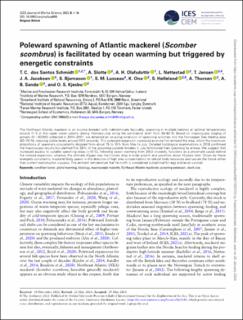| dc.contributor.author | dos Santos Schmidt, Thassya Christina | |
| dc.contributor.author | Slotte, Aril | |
| dc.contributor.author | Olafsdottir, Anna H. | |
| dc.contributor.author | Nøttestad, Leif | |
| dc.contributor.author | Jansen, Teunis | |
| dc.contributor.author | Jacobsen, Jan Arge | |
| dc.contributor.author | Bjarnason, Sigurvin | |
| dc.contributor.author | Lusseau, Susan Mærsk | |
| dc.contributor.author | Ono, Kotaro | |
| dc.contributor.author | Hølleland, Sondre Nedreås | |
| dc.contributor.author | Thorsen, Anders | |
| dc.contributor.author | Sandø, Anne Britt | |
| dc.contributor.author | Kjesbu, Olav Sigurd | |
| dc.date.accessioned | 2024-01-29T14:21:15Z | |
| dc.date.available | 2024-01-29T14:21:15Z | |
| dc.date.created | 2024-01-17T10:11:34Z | |
| dc.date.issued | 2023 | |
| dc.identifier.citation | ICES Journal of Marine Science. 2023, . | |
| dc.identifier.issn | 1054-3139 | |
| dc.identifier.uri | https://hdl.handle.net/11250/3114360 | |
| dc.description.abstract | The Northeast Atlantic mackerel is an income breeder with indeterminate fecundity, spawning in multiple batches at optimal temperatures around 11°C in the upper water column during February–July along the continental shelf from 36–62°N. Based on macroscopic staging of gonads (N ∼62000) collected in 2004–2021, we detected an on-going extension of spawning activities into the Norwegian Sea feeding area (62–75°N), reaching stable levels around 2012 onwards. This poleward expansion increased as more fish entered the area, whilst the maximum proportions of spawners concurrently dropped from about 75 to 15% from May to July. Detailed histological examinations in 2018 confirmed the macroscopic results but clarified that 38% of the spawning-capable females in July terminated their spawning by atresia. We suggest that increased access to suitable spawning areas (≥10°C), following ocean warming from 2002 onwards, functions as a proximate cause behind the noticed expansion, whereas the ultimate trigger was the historic drop in body growth and condition about 10 years later. Driven by these energetic constraints, mackerel likely spawn in the direction of high prey concentrations to rebuild body resources and secure the future rather than current reproduction success. The ambient temperature that far north is considered suboptimal for egg and larval survival. | |
| dc.language.iso | eng | |
| dc.title | Poleward spawning of Atlantic mackerel (Scomber scombrus) is facilitated by ocean warming but triggered by energetic constraints | |
| dc.title.alternative | Poleward spawning of Atlantic mackerel (Scomber scombrus) is facilitated by ocean warming but triggered by energetic constraints | |
| dc.type | Peer reviewed | |
| dc.type | Journal article | |
| dc.description.version | publishedVersion | |
| dc.source.pagenumber | 16 | |
| dc.source.journal | ICES Journal of Marine Science | |
| dc.identifier.doi | 10.1093/icesjms/fsad098 | |
| dc.identifier.cristin | 2228372 | |
| dc.relation.project | Norges forskningsråd: 299554 | |
| dc.relation.project | Havforskningsinstituttet: 15205 | |
| cristin.ispublished | true | |
| cristin.fulltext | original | |
| cristin.qualitycode | 2 | |
